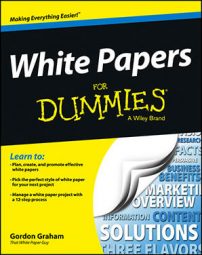A numbered list white paper really shines when you need some quick content to promote in a blog, e-newsletter, or magazine — or to meet some commitment in your marketing calendar. Numbered lists, in fact, are the quickest and easiest type of white paper to create. They can present an almost random set of points without demanding any deep logical explanation that connects all the dots.
In particular, a numbered list is likely the best flavor to pick in three specific situations:
To get attention with provocative views
To nurture prospects already in the funnel
To cast FUD — fear, uncertainty, and doubt — on competitors
Get attention for your white paper with provocative views
One fun way to use a numbered list is to come up with a new, slightly racy, or provocative twist on some issue. As your list is picked up, retweeted, and commented on, it can attract a lot of attention that your company never had before. You can even use a sarcastic or comedic approach that pokes fun at some sacred cow or unchallenged belief in your market space.
Here are a few examples of possible provocative white papers done in this way:
“5 Issues to Remember about Team Building”
“6 Gotchas in Disaster Recovery”
“7 Things Hackers Know about Your Network That You Don’t”
“8 Secret Ratios Wall Street Uses to Stonewall Your Company”
Don’t be provocative just for the sake of being provocative. Each of your items should make a real point that can help your target reader understand an issue, solve a problem, or make a decision.
Nurture existing prospects with your white paper
The middle of the sales funnel can be a lonely place. The selection committee has to draw up a list of requirements and beat the bushes for any possible vendors who can likely meet their needs. Often each vendor needs to send in a multipage answer to an RFP. Then each vendor must be vetted and their offering evaluated.
For a major B2B purchase, this process can take months, and for a truly major purchase, even years.
A light and lively numbered list can be just the thing to send to prospects stuck in the waiting game. Doing so enables your firm to “ping” prospects again to help them remember you. And it gives you another chance to position your firm as a company that B2B buyers can trust and enjoy working with. A numbered list may get noticed when a heavier white paper may not.
Cast FUD on competitors with your white paper
Tearing something down is easier than building it. You can apply this maxim to a numbered list designed to undermine your competitors: All you have to do is tear down someone else’s offering, not build a better offering yourself. This approach touches on the classic marketing tactic of tainting your competitors with FUD — fear, uncertainty, and doubt.
Virtually, every big corporation at some point resorts to FUD. This tactic is most useful when you and a competitor are locked in a battle for market share and repeatedly find yourselves on the same shortlist of B2B vendors.
A numbered list can do a lot to knock the other guy off the list.
Fear of failure and embarrassment: B2B buyers are in it for their companies, sure, but they’re also in it for themselves: their own careers, bonuses, raises, and achievements. No one wants to be known as “that goof who caused all those problems by picking the wrong system.” If a numbered list can succeed at raising concerns about other solutions that B2B buyers are considering, those buyers will take note.
Uncertainty about hidden flaws: Every vendor wants to reassure B2B buyers that it’s a solid outfit. If a numbered list lobs a few giant boulders that manage to crack the carefully constructed foundations of a competitor, it’s doing its job. One effective way to do this is to uncover any operating limits or unintended consequences of other solutions, stating that your white paper is out to reveal the “truth.”
Doubt about claims and features: An effective numbered list can keep up a steady barrage of sniping questions about the claims and features of other vendors. With these questions, a numbered list can shift the reader’s attention toward any perceived weaknesses in the competing solutions — and away from any perceived weaknesses in your own. Done skillfully, this approach can tilt the entire playing field to your own advantage.
You should never lie, fabricate evidence, or even stretch the truth beyond recognition in any white paper. White papers must use facts and logic to make its point. If FUD is distasteful to you, don’t use it. But be aware that your competitors may not feel the same way, and they may hit you with a numbered list carrying a huge payload of FUD.

